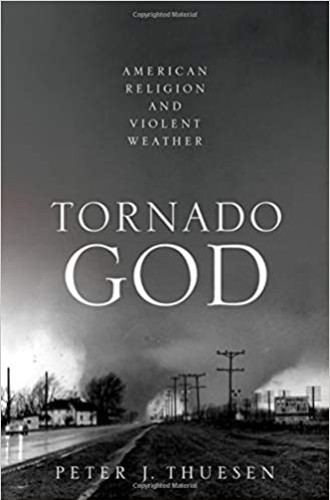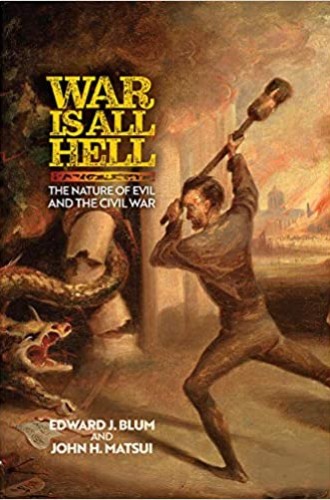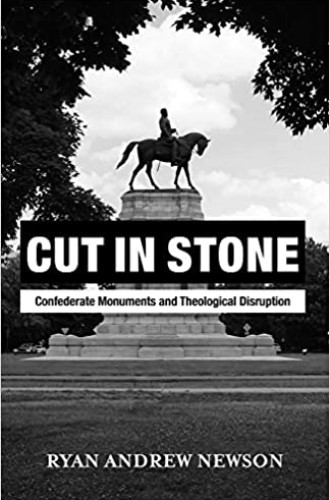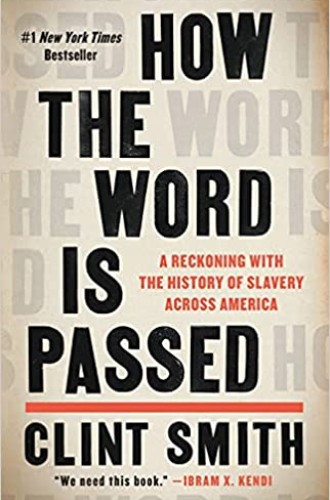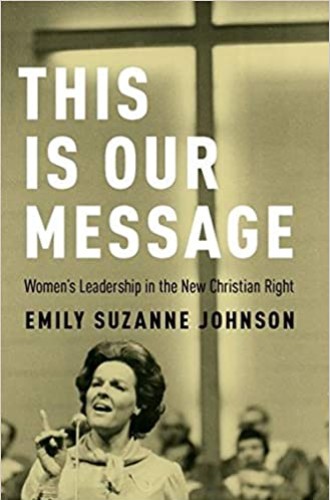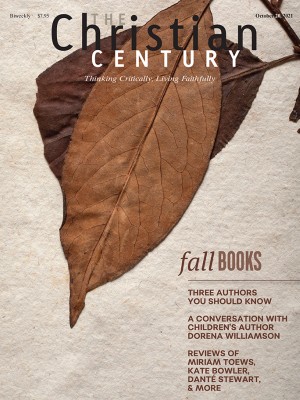Take & Read: American religious history
Five new books about myths and narratives that shape religion in the United States
We Americans take our myths seriously. Peter Thuesen’s Tornado God: American Religion and Violent Weather (Oxford University Press) sets the stage for a handful of books on American myths. Thuesen demonstrates that tornadoes, “peculiarly American” and “religiously primal” phenomena, matter deeply to American views of God’s care for the nation. The storm watchers he writes about assume God’s protective power. But even now when a tornado hits with near-incomprehensible force, humans experience something akin to Rudolf Otto’s sense of the holy, inexplicable but unquestionably real. That reality presents a “profound theological problem”: What is God’s role in these storms?
The problem has shifted over the centuries. In colonial New England, weather conditions provided frequent raw material for explorations of God’s protection and chastisement of human beings. The belief that God both caused and gave shelter from storms puzzled that generation. In the 19th century, tensions between expanded scientific knowledge and the “fervent apocalypticism” of some religious movements sharpened questions about God’s relationship to natural laws. By the 20th century, Americans had a growing awareness of the scientific details about tornadoes but still no control over them.
Read our latest issue or browse back issues.
The questions persist into our own time, perhaps most pointedly in Oklahoma. There, “the evangelical culture of middle America meets the frontiers of meteorology” at the University of Oklahoma’s National Weather Center and NOAA’s Storm Prediction Center. In Tornado Alley, God’s role in storms still engenders theological debate—and human beings’ role in climate change is the subject of scientific inquiry.
It may seem odd to jump from debates about extreme weather to Civil War–era claims about the reality of evil. Yet both Thuesen’s study of meteorological theodicy and Edward Blum and John Matsui’s War Is All Hell: The Nature of Evil and the Civil War (University of Pennsylvania Press) investigate Americans’ struggle to understand the world around them in theological terms. Other historians have examined the Civil War for invocations of the divine. This book instead looks for references to the devil.
Blum and Matsui weave a compelling narrative that shows how, before the war, satanic imagery and language were relatively rare, especially in reference to battlefield comportment. Beginning with southern secession, however, political and theological debates North and South bubbled over with accusations: Republicans and abolitionists suffered from demon possession, the Confederates were manipulated by Satan.
During the war, soldiers used the language of hell to describe what they saw, heard, felt, and smelled. Before the conflict exploded, soldiering was seen as a godly duty. When cannon and cavalry brought unaccountable destruction, however, these troops felt trapped in hell, fighting opponents they described as devils. Texts and images portrayed President Lincoln as either possessed by the devil or as Lucifer himself. To fight like a devil became not only a rallying cry among the troops but also an approved strategy.
Blum and Matsui’s argument’s mythmaking payoff comes in the book’s epilogue, which meditates on the aftermath of the war, Reconstruction, and White acts of terror against Black people. White people from North and South alike wanted reunion with each other and prosperity for themselves more than they wanted accountability. They “blam[ed] the devil, rather than themselves, for the earlier discord.” Black people in the reunited country, however, wanted justice. They wanted some acknowledgment by White people everywhere that their suffering had not ended. The failure of Reconstruction, the rise of the Ku Klux Klan and lynching, and the imposition of Jim Crow laws made life hellish for Black Americans. The myth of White supremacy—no less powerful for being untrue—strengthened its devilish hold on American soil.
Ryan Andrew Newson’s book Cut in Stone: Confederate Monuments and Theological Disruption (Baylor University Press) picks up where Blum and Matsui leave off. Newson invites readers to reflect on the historical, theological, and practical problems posed by Confederate monuments still marking the American landscape.
The book’s cover features the Robert E. Lee memorial in Richmond, Virginia, which was dedicated in 1890 and removed last month just as I read Newson’s book. It was constructed, Newson explains, “in a part of [Richmond] that had yet to be built,” in effect staking a claim on “Richmond’s future and beckon[ing] the city toward him.” In Newson’s analysis, these memorials perform the work of closing off possible futures, consigning everyone in their presence to repeat the White supremacist sins of the past.
Newson focuses on monuments erected decades after the Civil War. Rather than standing in cemeteries to mournfully mark graves, these later monuments, installed in public places, deliver “apologetics, and blatant expressions of white superiority,” maintaining silence about slavery and propounding the Lost Cause myth, which claims that White southerners acted justly and virtuously in slaveholding, seceding, and conducting the war. From 1885 to the 1910s, against a backdrop of Klan lynchings and Jim Crow laws, these monuments rose and were dedicated in elaborate ceremonies infused with Christian language and symbols.
Newson draws on the work of theologians Serene Jones and Shelly Rambo to formulate a strategy for “disrupting” the monuments’ continuing claims on us viewers. Monuments left in place might be “altered” in ways that allowed viewers “passage through wounds.” What such passage looks like is unclear, but it offers an alternative to removing monuments, which will not, Newson warns, complete the work of antiracism.
Poet Clint Smith offers a model for passing through wounds in How the Word Is Passed: A Reckoning with the History of Slavery across America (Little, Brown). He devotes a chapter to each of eight places he visited between late 2017 and early 2020, asking “how each reckons with its relationship to the history of American slavery.”
Smith’s travels include his hometown of New Orleans; Monticello plantation in Virginia; Louisiana’s Whitney Plantation; the Louisiana State Penitentiary, known as Angola, built on a former Louisiana plantation and still extracting all-but-unpaid labor from an overwhelmingly Black population; Blandford Cemetery in Virginia, where thousands of Confederate soldiers’ remains were reinterred by the Ladies’ Memorial Association in the 1890s and where the tour guide described visitors not as Confederate “sympathizers” but as people with “Confederate empathy”; Ashton Villa on Galveston Island, where Union general Gordon Granger was said to have read the order freeing Texas’s enslaved people on June 19, 1865; New York City, the second largest slave market in the United States behind Charleston, South Carolina; and Gorée island, Senegal, site of the Door of No Return, where tradition holds that thousands of enslaved Africans left their familiar lives behind.
Space does not permit a full review of what Smith experienced at each site. At several locations, he seeks a Newson-like renarration of what is commemorated. He confronts powerful American myths everywhere. Indeed, his Monticello tour guide told Smith he realized “that there’s a difference between history and nostalgia, and somewhere between those two is memory. . . . history is kind of about what you need to know . . . but nostalgia is what you want to hear.” If Monticello presents nostalgia, the Whitney Plantation aims for history by “mak[ing] the story of the enslaved the core of the experience.” Unlike at Monticello, the Whitney tour guides Smith saw were almost all Black women. By acknowledging the painful history of enslavement, Whitney may offer these women—and its Black and White visitors—a passage through wounds.
A very different book from these other studies of memory, history, and myth is Emily Suzanne Johnson’s This Is Our Message: Women’s Leadership in the New Christian Right (Oxford University Press). The women in Johnson’s cohort—Marabel Morgan, Anita Bryant, Beverly LaHaye, and Tammy Faye Bakker, plus Sarah Palin and Michele Bachmann taken together in a kind of coda—shattered some prevailing myths about midcentury anti-feminist women and evangelical conservatives.
Morgan disavowed anything political about her workshops or her best seller The Total Woman. Yet Johnson argues that she deserves credit for arming evangelicals with a critique of a lax sexual culture that could be activated for political purposes in later decades—by someone like Bryant, for instance, who founded Save Our Children to repeal the Dade County, Florida, antidiscrimination law protecting gay and lesbian employees. Bryant’s successes were fleeting, her time in the political fray brief, but she modeled conservative female politics for millions of women and men. LaHaye’s Concerned Women for America, by contrast, still stands as the largest lobby of its kind.
Like Morgan, Bakker focused her energy on avowedly apolitical concerns like makeup and clothes, using them to attract women and not a few men to her message. Johnson holds up Bakker’s embrace of people with HIV and AIDS as a political breakthrough. She did not want to rub elbows with political leaders, but by calling out homophobia on her television program, Bakker took a controversial political stance as a Christian conservative.
Johnson argues that the political movement spurred by conservative evangelicals depended on women’s leadership as well as men’s. By addressing women’s concerns about marriage and motherhood with professional polish and up-to-date savvy, Johnson’s subjects created outposts of a traditionalism that was attractive, persuasive, even fun. Generations of American women who rejected feminism flocked to read their books, attend their conferences, and join their organizations. The alliances between these women and Morgan, Bryant, LaHaye, and Bakker, sustained by successful communication networks, helped build a conservative White evangelical infrastructure that communicated powerful norms to millions of households.
Here is where Johnson’s evangelical women encounter Thuesen’s weather watchers and the myth of White supremacy. The actors in these books share a national and mythic geography and have imbibed narratives about God’s providential care for Americans. Johnson’s women appealed to moderate and conservative women—mostly suburban, privileged by Whiteness to forego political activism—for their consent to received traditions, what Newson calls the “performed neutrality” of prevailing myths. The power of Whiteness as an American norm, baptized by Christian claims, continues—a reality that challenges the nation to undertake a renarration of our national and theological identities.
Read Joshua Jipp's New Testament selections, Susan Willhauck's practical theology selections, and Philip Jenkins's global Christianity selections.
A version of this article appears in the print edition under the title “Take & Read: American religious history.”


